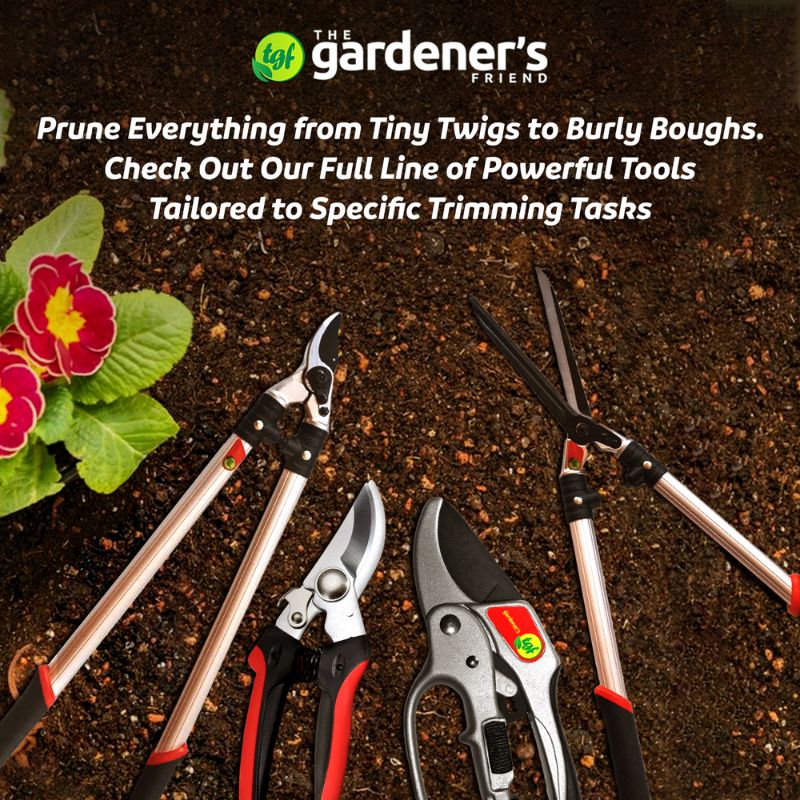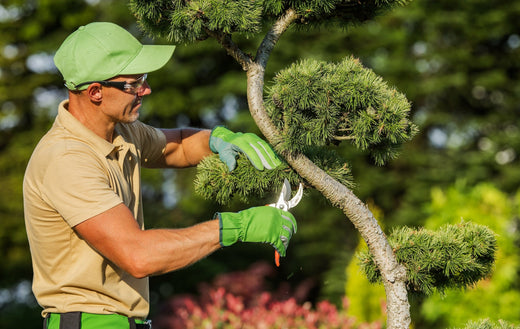Choosing The Right Pruners
Welcome to The Gardener’s Friend, where we grow our love for all things green and growing. Today we’re pruning into the world of pruners, bypass or anvil? Whether you’re an old hand or a beginner, choosing the right pruner for your garden can make all the difference. So grab a cuppa and a chair and let’s find out which pruner is right for you. We’ll make your garden bloom!
Quick Summary
In this post we’ll be looking at bypass and anvil pruners. Bypass pruners with their scissor action are perfect for clean cuts on living branches, keeping your plants healthy. Some are designed for right handed users for comfort and ease of use while gardening. Anvil pruners with their robust design are great for cutting tougher, dry wood by applying more cutting power. Depending on your gardening needs and plants, having both pruners might be the key to a blooming garden.
Pruner Types
When it comes to pruning, having the right tool for the job is crucial. At first glance it may seem like all pruners are the same, but there are key differences between anvil and bypass pruners that can make all the difference in your gardening experience.
Bypass pruners, also known as bypass secateurs, have two sharp blades that glide past each other like a pair of scissors. This design allows for clean cuts, making them perfect for pruning live, green branches. The sharp blade of a bypass pruner cuts the plant tissue smoothly, which helps the plant heal quickly and reduces the risk of disease. If you’re working with delicate plants or need to make precise cuts, bypass pruners are the tool for the job.
Anvil pruners have a single cutting blade that closes onto a flat surface, or anvil. This design is more robust and is great for cutting tougher, thicker branches and dead wood. Anvil pruners are good for cutting dead branches or thicker stems that don’t require the same level of precision as live plants. But they can crush the plant material so aren’t ideal for green, living branches.
Knowing these differences will help you choose the right pruner for your gardening needs. Whether you’re trimming delicate roses or cutting back dead wood, having the right tool makes pruning easier and more effective. So next time you head out to the garden, take a minute to think whether an anvil or bypass pruner is the tool for the job. Happy pruning!

Quick Facts
- Bypass pruners for clean cuts to keep plants healthy.
- Anvil pruners for cutting dry, thick branches.
- Both anvil and bypass pruners are good for different tasks. Using an anvil pruner for general pruning will often mean using the wrong tool as it can crush sensitive plant tissue compared to the clean cut of bypass pruners.
- Consider plant and branch thickness.
- New to gardening? Use both pruners for different tasks.
Anvil or Bypass Secateurs for Pruning
Gardening is a great way to get connected with nature and choosing the right pruner to prune your plants can make your time in the garden even more fun. When it comes to cutting tools, knowing the difference between anvil and bypass pruners is key to effective pruning. You may wonder why choosing anvil secateurs over bypass pruners or vice versa even matters. Well, let me tell you, each has its own charm and use and choosing the right one can make all the difference to your beloved plants.
Let’s start with the bypass pruners. Bypass pruners, also known as bypass secateurs, are loved by many gardeners because they work like a pair of scissors. These cutting tools have two blades that pass by each other smoothly for a clean cut. Bypass pruning loppers work like a pair of scissors so they have an advantage when you need to cut live, green stems. Unlike anvil tools, bypass pruners don’t crush the plant material so are great for keeping your plants healthy and structured. If you’re tending to delicate roses or shrubs that need that gentle touch, bypass pruners are the way to go.
Now let’s look at the anvil pruners. Anvil secateurs have a single blade that closes onto a flat surface like a knife on a cutting board. This design is a bit more robust so an anvil pruner is great for cutting through dry, dead or thicker wood. Anvil loppers or pruners give more power to each cut so you can cut through tougher, thicker branches quickly. But do note they may not be suitable for green wood as they tend to crush rather than cut. When choosing between anvil and bypass pruners, consider the type of branches you’ll be working with.
You’re probably thinking one tool can do it all. While each has its strengths, having both may be the way to go if you have a mix of live foliage and old dry wood in your garden. In the bypass vs anvil debate there’s no one size fits all answer; it’s about matching the tool to the task. Bypass pruners will be your go to for those fresh cuts and anvil pruners for the sturdier dry wood.
Our friend Fred Hoffman always says, “It’s not just the tool, but how you wield it.” With that in mind at The Gardener’s Friend we believe in encouraging every gardener to find the tools that resonate with them. You have the knowledge to make the best choice and with a little practice you’ll be wielding your bypass secateurs or anvil tools like a pro. Happy gardening and happy pruning!

Bypass vs Anvil Pruners for Garden Branches
I’ve been gardening for a while now and I’ve learned a thing or two about the little things that make a big difference. One of those often overlooked heroes in our gardening toolkit is the humble pruner. Today we’re going to talk about the pros and cons of bypass vs anvil pruners so you can make the best choice for your garden branches. It may seem like a small decision but when it comes to our beloved plants and trees it’s a big deal.
Now let’s start with bypass pruners. These are like the surgical tools of the gardening world, perfect for when you need precise cuts. Bypass pruners work like a pair of scissors where one sharp blade sweeps past a flat surface or another sharp blade. This is great for pruning live plant branches as it gives a smoother cut. Smooth cuts help your plants or trees to heal quickly and reduce the risk of damage or disease. Whether you’re nurturing new growth or shaping young trees, bypass pruners give you that gentle touch we need in our gardens.
But what about when you’re dealing with thicker, tougher, dry wood and branches? This is where anvil pruners come into their own. Unlike bypass pruners, anvil pruners have a simple design with a single sharp blade that closes onto a flat edge or ‘anvil’. This mechanism crushes rather than slices through the stem which makes them perfect for pruning dead wood or branches that don’t need that surgical precision. If you have some heavy duty cutting to do like trimming back shrubs or dealing with stubborn woody branches, anvil pruners are the tough tools you need in your shed.
Imagine your old mate Fred popping into your garden for a chat. He’d say “it’s all about having the right tool for the job”. Each has its role: bypass pruners for living branches, promoting healthy growth and quick healing, and anvil pruners for those heavy duty cutting tasks with brute force. So what should you consider when choosing between these trusty tools? Look at your gardening habits and the type of wood and branches you encounter. Look at the strength you need for your typical cutting tasks and the health requirements of your plants and trees.
Having both types of pruners might be the way to go. After all our gardens are always changing and each plant or tree we care for has different needs. By having bypass and anvil pruners we’re not only preserving our beautiful gardens but also being prepared for all the cutting challenges that come our way. Happy pruning friends and remember, whether you choose an anvil or bypass, it’s always about loving the garden space we all love. Till next time, take care!


